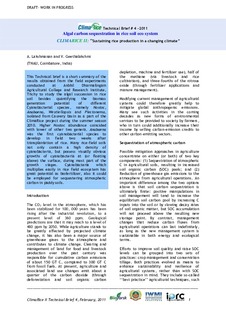| dc.description.abstract | This Technical brief is a short summary of the results obtained from the field experiments conducted at Anbhil Dharmalingam Agricultural College and Research Institute, Trichy to study the algal succession in rice soil besides quantifying the biomass generation potential of different Cyanobacterial species, namely Nostoc, Anabaena, Westiellopsis and Plectonema, isolated from Cauvery basin as a part of the ClimaRice project during the summer season 2010. Higher Nostoc abundance coincided with lower of other two genera. Anabaena was the first cyanobacterial species to develop in field two weeks after transplantation of rice. Many rice-field soils not only contain a high density of cyanobacteria, but possess visually obvious growths of cyanobacteria at (or floating above) the surface, during most part of the growth stages. Cyanobacteria which multiplies easily in rice field ecosystem has great potential as biofertilizer, also it could be employed for sequestering atmospheric carbon in paddy soils. | nb_NO |
